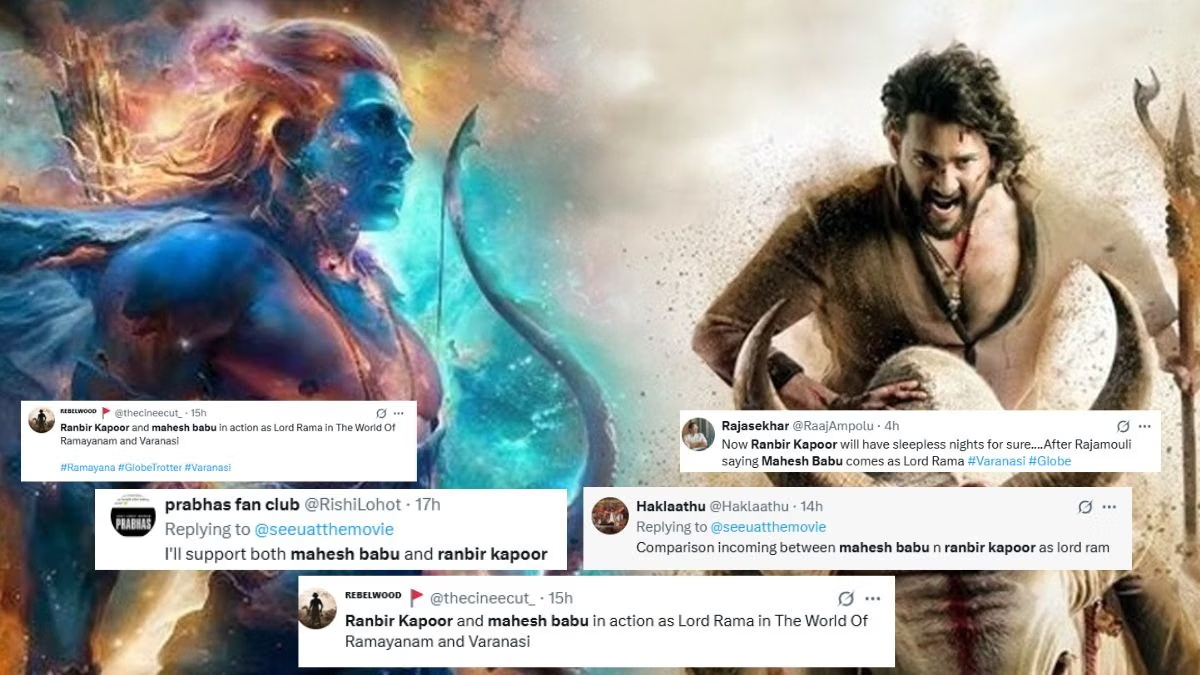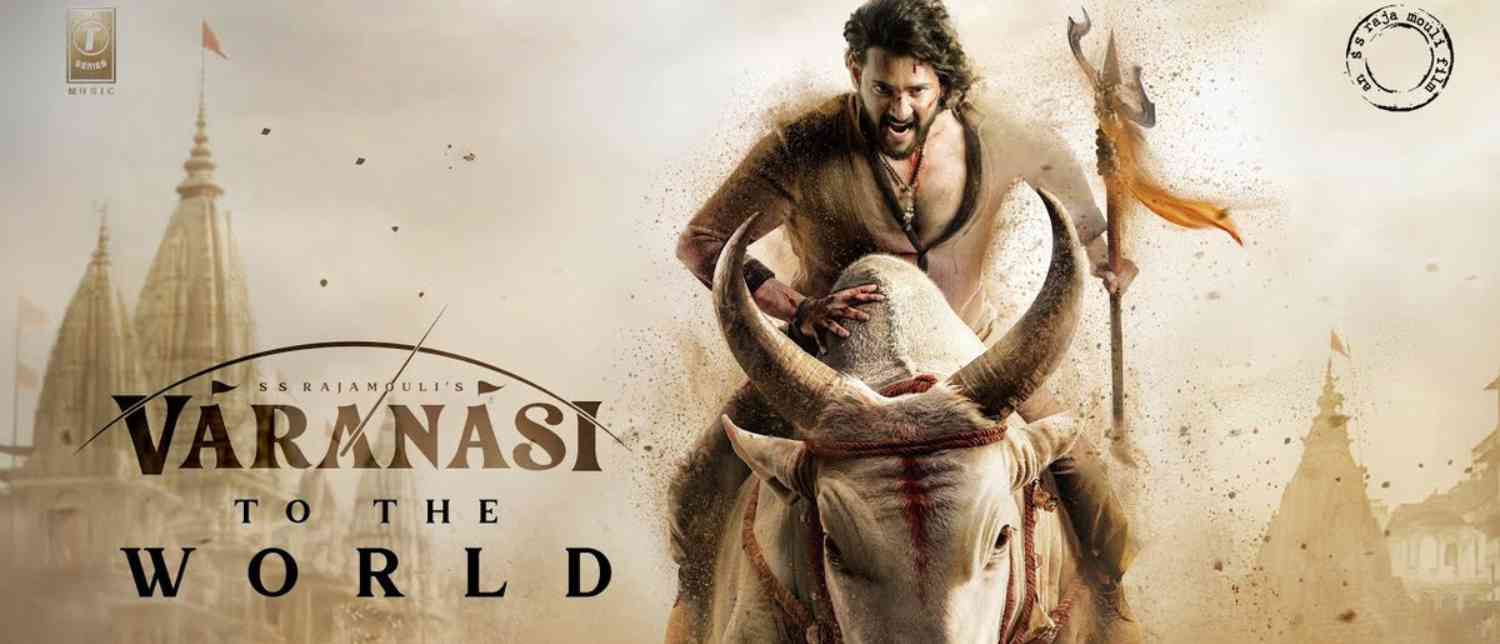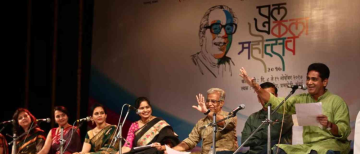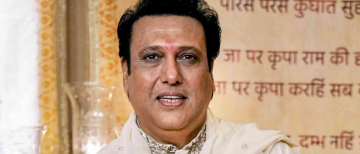Indian cinema is gearing up for a grand clash of mythological proportions. Two of the most awaited films of this decade—Nitesh Tiwari’s Ramayana and S.S. Rajamouli’s Varanasi—are headed for back-to-back releases, with Ramayana set to arrive in Diwali 2026 and Varanasi eyeing an early 2027 debut.
And if the early glimpses, star cast revelations, and production details are anything to go by, the next two years will be nothing less than a cinematic war for mythological supremacy.
On November 15, Rajamouli unveiled the title of his much-anticipated next film at a massive, never-before-seen event. The first glimpse of Varanasi left audiences stunned—thanks to its monumental VFX design, staggering scale, and otherworldly detailing. Though the makers have kept the plot tightly under wraps, fans already know that Priyanka Chopra plays Mandakini, Prithviraj Sukumaran takes on the antagonist Kumbha, and Mahesh Babu appears as Rudhra.
Naturally, moviegoers could not help comparing the timing and concept with Tiwari’s Ramayana, which has already created massive anticipation nationwide.

Why the Clash Matters: Mythology Rules Modern Indian Cinema
Indian cinema's fascination with mythology has always existed, but technology has amplified it dramatically. The turning point came with the arrival of Baahubali: The Beginning (2015) and Baahubali: The Conclusion (2017), Rajamouli’s monumental spectacles inspired by the Mahabharata, Amar Chitra Katha, and folk literature like Chandamama. These films revolutionised Indian filmmaking by proving that mythology, when paired with cutting-edge visuals and emotionally rich storytelling, can rewrite box-office history.
Since then, a wave of mythological and folklore-driven cinematic universes has emerged—from the Mahavatar Cinematic Universe to Maddock Films’ folklore-themed horror universe and Dominic Arun’s fantasy-folklore blends. The appetite for Indian epics is now at its peak.
In this evolving landscape, Ramayana and Varanasi are poised to redefine what modern mythological blockbusters can be.
Ramayana: A Faithful Cinematic Retelling of the Timeless Epic
While many films draw inspiration from mythology, Nitesh Tiwari’s Ramayana is a direct adaptation of Valmiki’s original epic. The film’s pre-production alone lasted ten years, involving meticulous work on world-building, dialogues, writing, and screenplay construction. This points to the sheer ambition behind the project.
A Stellar Cast That Has Fans Excited
The film features:
-
Ranbir Kapoor as Lord Shri Ram
-
Sai Pallavi as Sita
-
Yash as Ravana
Supporting roles include:
-
Amitabh Bachchan
-
Rakul Preet Singh
-
Kunal Kapoor
-
Lara Dutta
-
Arun Govil
-
Sheeba Chadha
The film will release in two parts—Part 1 during Diwali 2026 and Part 2 in Diwali 2027.
This is Tiwari’s first venture into mythology after the massive successes of Dangal and Chhichhore, and expectations are sky-high.
Varanasi: Rajamouli’s Bold Mythological-Fantasy Experiment
While Ramayana sticks closely to the original scripture, Rajamouli’s Varanasi attempts something fresh. Reports indicate that the director will depict one specific scene from the Ramayana but expand it into a multi-layered narrative blending time travel, Kali Yuga, and Treta Yuga.
This makes Varanasi not just a mythological epic—but a sci-fi fantasy grounded in Indian lore.
Cast Highlights
Confirmed roles include:
-
Priyanka Chopra as Mandakini
-
Prithviraj Sukumaran as Kumbha (the antagonist)
-
Mahesh Babu as Rudhra (with strong links to Lord Ram’s mythology)
Rajamouli’s reputation for visual mastery, world-building, and emotional storytelling has already set expectations sky high—yet, the film’s complexity has also triggered debates about whether it can surpass the scale of Ramayana.
The Big Debate: Who Makes the Better Lord Ram—Ranbir Kapoor or Mahesh Babu?
In an unexpected twist, both films feature cinematic interpretations of Lord Ram.
Ranbir Kapoor as Lord Ram in Ramayana
Ranbir plays the central role in Ramayana, and early glimpses released in July gained immense love online. Casting director Mukesh Chhabra praised Ranbir’s “childlike gentleness,” inner peace, and quiet strength—all qualities associated with Lord Ram.
Actor Ravie Dubey called his aura “quiet, graceful, and deeply committed,” reinforcing fan belief that Ranbir is perfect for a serene, spiritual portrayal.
Mahesh Babu as Lord Ram in Varanasi—But With a Twist
In Varanasi, Mahesh Babu’s appearance as Ram is said to be brief—but impactful. Fans argue that his magnetic charm and expressive face naturally suit mythological characters, especially Lord Krishna.
His radiant screen presence has already impressed viewers, with some even claiming he might overshadow Ranbir. After the Varanasi title reveal, social media was flooded with comments like:
“Ranbir Kapoor will now have sleepless nights.”
At the same time, many users praised both stars and urged fans not to turn this into a rivalry. But make no mistake—once the trailers drop, debates will intensify.
Ramayana vs Varanasi: The Creative Challenge
When two gigantic films belonging to the same mythological space release within months of each other, comparisons are inevitable.
Ramayana’s Advantage
-
A direct, faithful retelling of a globally revered epic
-
A decade-long preproduction phase
-
A powerhouse cast
-
Clear narrative direction
-
Cultural familiarity
Varanasi’s Challenge
Since Varanasi explores multiple genres—mythology, fantasy, time travel, sci-fi—balancing them might be tricky.
Rajamouli aims to bring something fresh, but the complexity of blending different eras and mythological references poses a creative risk.
Still, the director has repeatedly proven that he can handle complex worlds—so expectations remain massive.
The IMAX Battle: Who Will Deliver a True Large-Format Experience?
One of the most intense discussions among fans revolves around technology—particularly IMAX.
Both films are being designed for large-format cinematic release. But which one will give audiences a truly native IMAX experience?
Rajamouli’s Claim: Varanasi Will Be Shot in True IMAX
At the Varanasi launch event, Rajamouli openly stated:
-
The film is being shot directly in IMAX, not upscaled later
-
It will go beyond the expanded 1.90:1 IMAX used in Baahubali and RRR
-
He hopes India will have at least one 1.43:1 IMAX screen by the film’s release (the same format used in Oppenheimer)
This made Mahesh Babu fans declare Varanasi as India’s first true 1.43 IMAX film.
Ramayana’s Approach
Though the makers haven’t shared technical details, industry reports say:
-
Ramayana is using IMAX-certified camera technology
-
Select sequences may be shot in 1.43:1
-
The film’s massive sets and heavy VFX work align with IMAX sensibilities
The Reality: Hybrid IMAX Is the Future
Experts confirm that almost no film globally is shot entirely in 1.43:1 due to:
-
Extremely high cost
-
Limited equipment availability
-
The ratio's impracticalities for narrative scenes
Thus, both Ramayana and Varanasi will likely blend:
-
1.43:1 IMAX sequences
-
1.90:1 expanded IMAX scenes
-
standard widescreen shots
Regardless, audiences are guaranteed a visually breathtaking experience in both films.

Which Film Will Rule the Epic Race?
As Indian cinema enters a new era of grand mythological filmmaking, the arrival of Ramayana and Varanasi marks a historic moment.
On one hand, Ramayana offers:
-
A pure retelling of one of India’s most sacred epics
-
A serene, spiritually faithful version of mythology
-
A massive emotional anchor through Ranbir’s portrayal
On the other, Varanasi brings:
-
A daring genre fusion
-
Rajamouli’s unmatched world-building vision
-
A dynamic, larger-than-life Mahesh Babu
Both films promise revolutionary use of IMAX, groundbreaking VFX, and some of the finest actors working today.
The Verdict?
It’s not Ramayana vs Varanasi—it’s Indian cinema winning on both sides.
Audiences will witness two epic sagas—each distinct, ambitious, and visually unforgettable—that will push the boundaries of Indian filmmaking like never before.
With inputs from agencies
Image Source: Multiple agencies
© Copyright 2025. All Rights Reserved. Powered by Vygr Media.
























